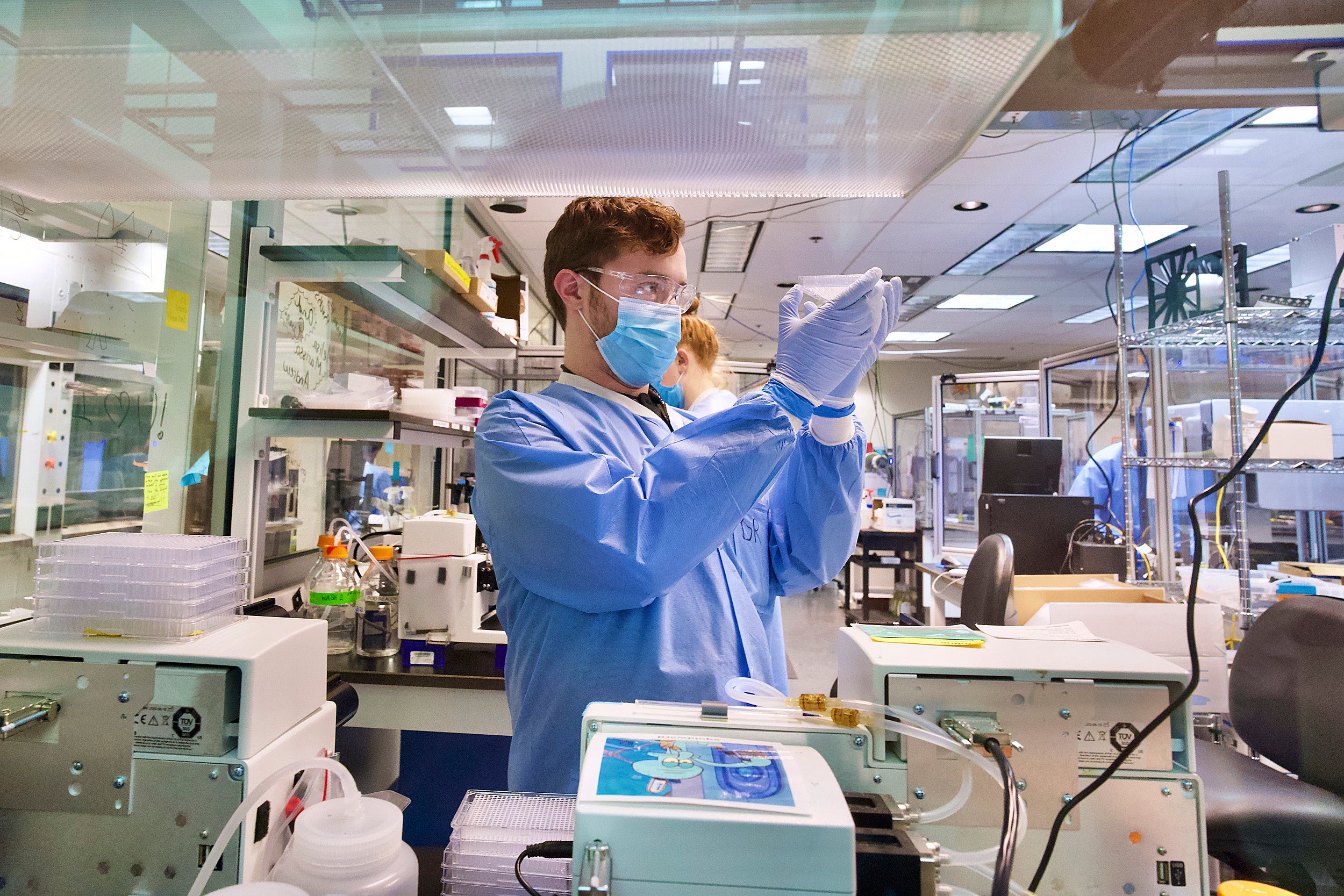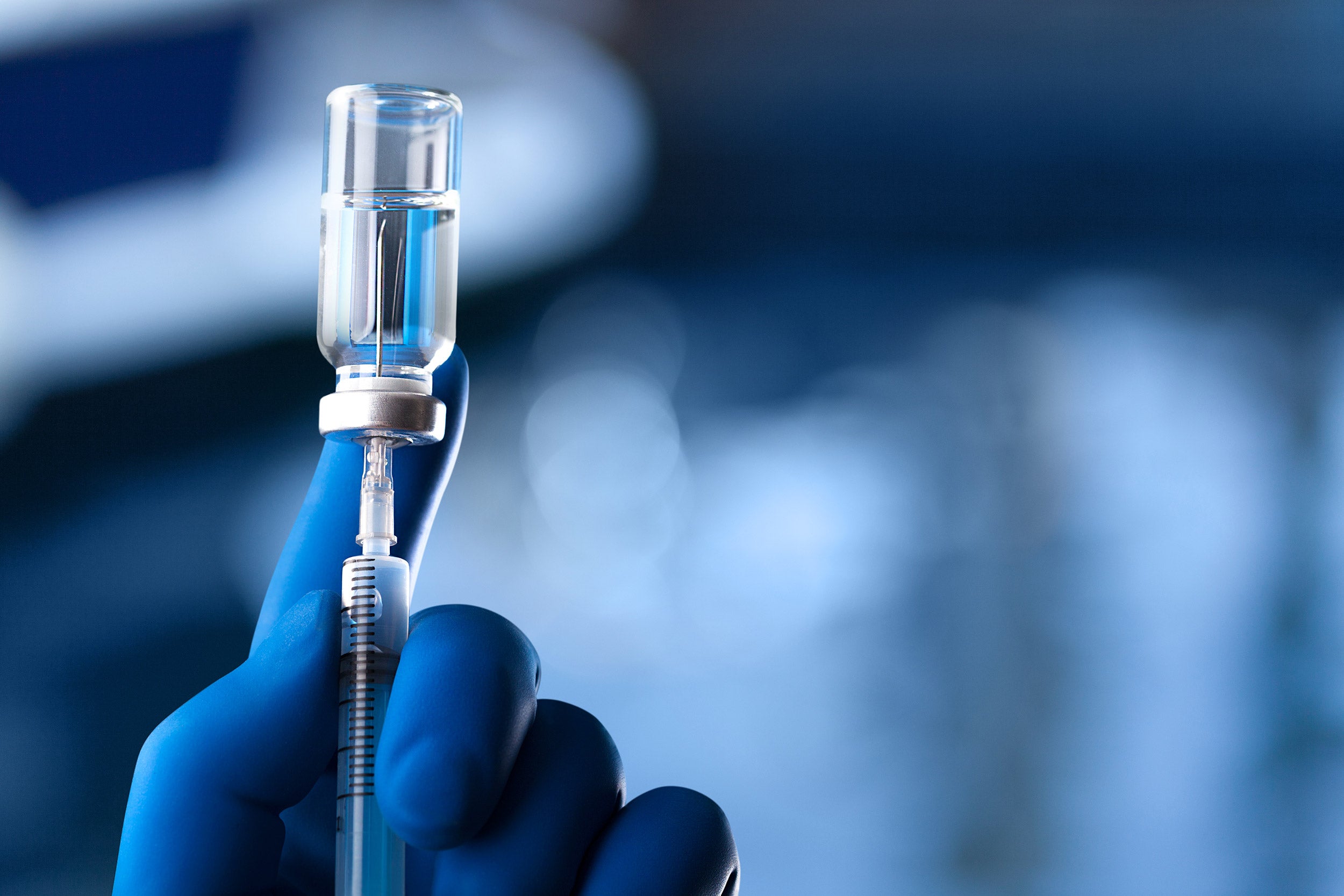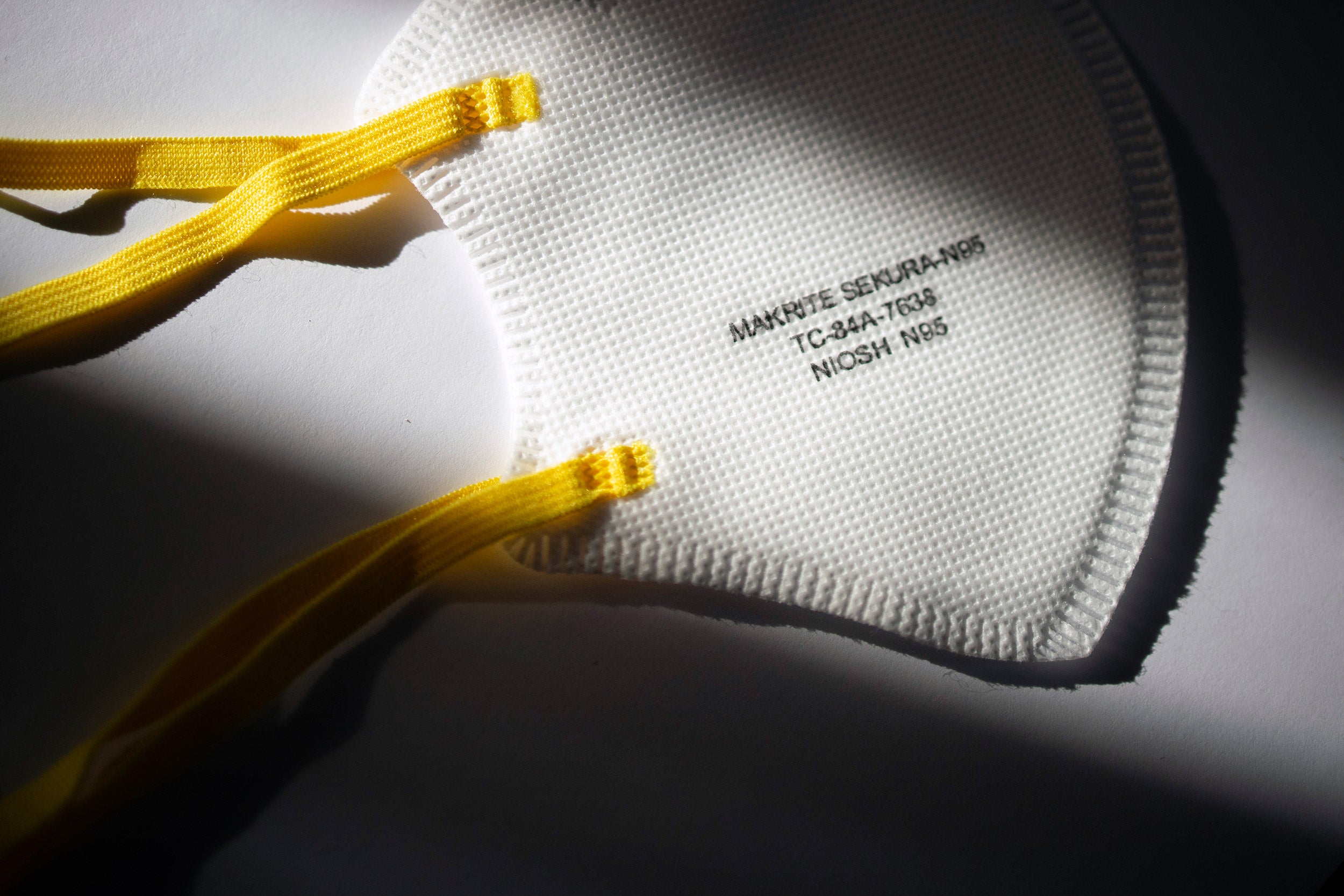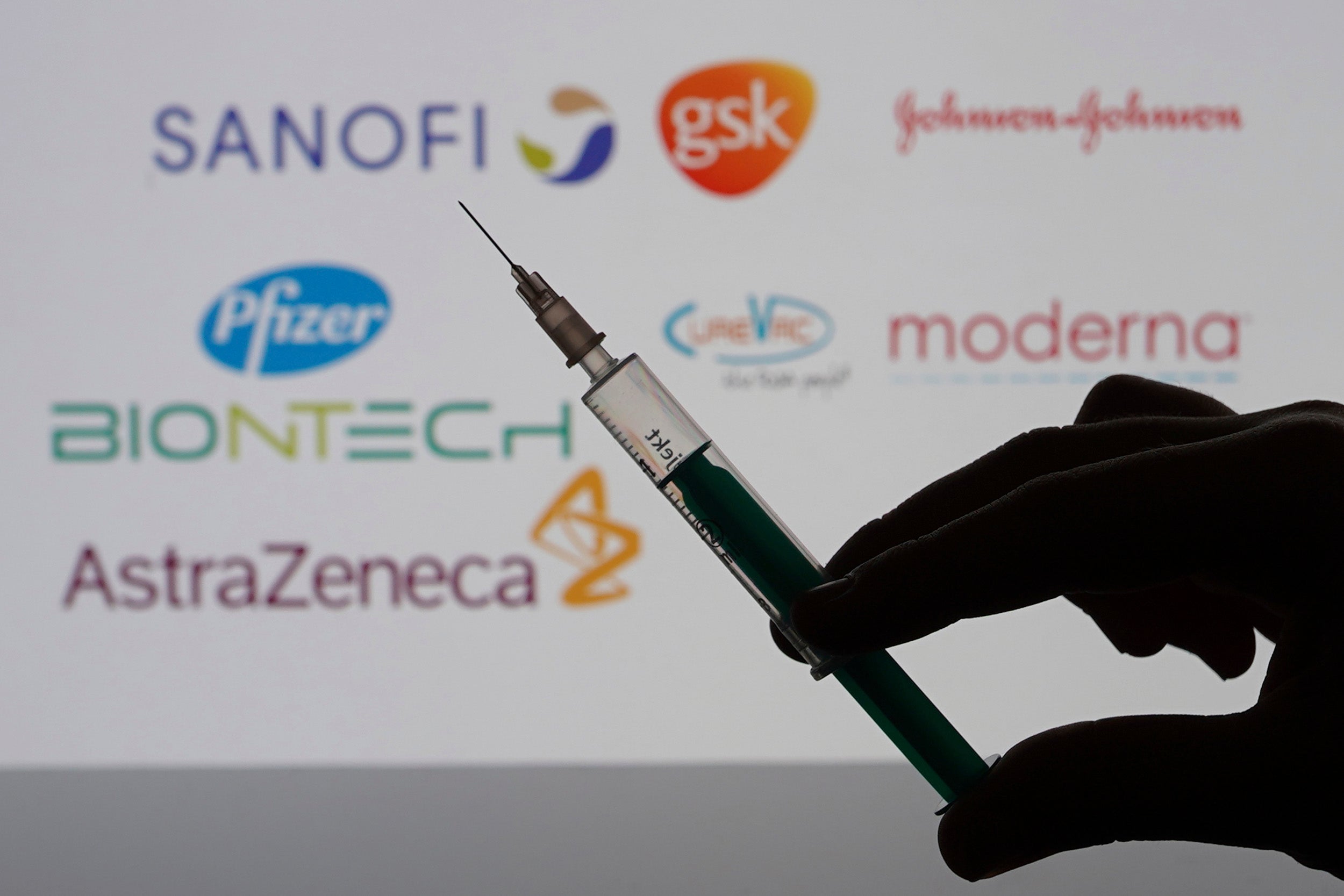
Daniel Roberts, an accessioning technician at the Broad Institute, conducts COVID-19 screening.
Scott Sassone/Broad Institute of MIT and Harvard
Looking back on Harvard’s COVID response one year later
Health experts, leaders, and staff offered input, helped devise policy and procedures
A year ago today, President Larry Bacow informed the Harvard community that the University would be transitioning to remote instruction as COVID-19 intensified its grip on the world, with hospitalizations and deaths in the United States beginning to rise at alarming rates.
“Like all of you, I have been intently following reports of Coronavirus Disease 2019 (COVID-19) and considering the many ways in which its future course might alter my life and the lives of those closest to me,” he wrote. “These past few weeks have been a powerful reminder of just how connected we are to one another — and how our choices today determine our options tomorrow.”
The next day, the World Health Organization declared the COVID-19 outbreak a pandemic. Two days after that, President Donald Trump issued a national emergency.
“The decision to move to virtual instruction was not made lightly,” Bacow wrote in his March 10, 2020, message. In fact, health experts, leaders, and staff from across Harvard’s Schools and units had already begun meeting on a daily basis starting in January 2020, when the initial outbreak of the novel coronavirus was first reported in Wuhan, China. These meetings would go on to inform the policies and procedures that would successfully limit the spread of COVID-19 on campus over the course of the year to come, while maintaining the University’s commitment to research and teaching.
At the time of Bacow’s announcement, few in the popular media predicted that policies regarding remote work and instruction, physical distancing, mask-wearing, and frequent testing would still be in place a year later. Yet Harvard quickly assembled advisory groups with some of the foremost experts in public health, medicine, and science, from both within Harvard’s community and outside, to prepare for the very real possibility that COVID-19 might become a longer-term problem. In many ways, the University and the rest of the world were moving into uncharted territory, and Harvard’s leadership was committed to ensuring it had the best and most up-to-date information as it made ongoing decisions.
In May, Provost Alan M. Garber, who had himself studied pandemic preparedness earlier in his career, convened the University Coronavirus Advisory Group (UCAG) to discuss the latest research and data and make recommendations on policies and protocols that would allow Harvard to move forward as safely as possible. The group, which still meets on a regular basis, is a who’s who of clinicians, public health experts, and scientists. It also includes leaders in other disciplines, such as Robert Huckman, faculty chair of the Harvard Business School Health Care Initiative. Law Professor Cass Sunstein, an expert in behavioral economics, was a member until joining the Department of Homeland Security as a senior counselor, as was Rochelle Walensky before President Biden named her to direct the Centers for Disease Control and Prevention.
During early meetings of the group, Walensky shared her own research modeling virus spread inside university populations to inform Harvard’s decisions on testing and other approaches to control potential outbreaks on campus. And the School of Public Health’s Michael Mina and Joe Allen offered critical perspective on rapid testing for the virus and ventilation engineering controls to minimize exposure.
The group also drew, and continues to draw, on expertise and collaborations with leaders at nearby institutions: MIT’s Vice President for Research Maria Zuber, recently named co-chair of the President’s Council of Advisers on Science and Technology, is a member of the committee, as is Jim Collins, a professor of medical engineering and science at MIT who conducts research at the Broad and Wyss institutes.
“Among Harvard’s faculty, students, staff, researchers, and alumni are some of the foremost experts in the world on an astounding range of issues,” said Garber. “Throughout the pandemic, our network of public health and medical experts were highly sought out by schools, businesses, governments, and the public, and graciously gave their time to also advise the University. Their insights, drawn from observations on the front lines of medical care as well as research and expertise in a large number of disciplines, rapidly established the University’s common understanding about the virus and informed the protocols and practices that have served us well in limiting transmission on campus. With their guidance, the University was able to adapt, innovate, and continue to advance its teaching and research missions.”
More like this
According to UCAG member Paul Biddinger, medical director for the Division of Emergency Preparedness at Mass General Brigham (MGB), the group has advised the Harvard administration on issues ranging from very specific infection control policies or procedures, such as whether to wear gloves and what kinds of masks are most effective; to providing recommendations on safety guidelines for indoor activities, given the most up-to-date understanding on the transmission of the virus; to how the University should care for individuals ill with COVID; to what kind of contact-tracing programs are the most effective. Committee members also made suggestions on how to communicate all of this information to Harvard’s diverse constituent groups.
In the past, Biddinger has led Harvard leadership through pandemic simulations that addressed many of the realities with which we have become all too familiar over the past year, including physical distancing, remote learning, and the use of personal protective equipment. In his view, what was new this year was the critical emphasis on testing that the University decided to adopt early on. Harvard was able to leverage its strong relationship with the Broad Institute, which had converted part of one of its labs into a COVID-19 testing facility by March 2020, to test community members.
According to Michael Springer, an associate professor of systems biology at Harvard Medical School who was involved in developing and implementing Harvard’s high-throughput COVID-19 testing strategy, the diversity of the UCAG’s expertise and the collegiality of its members went a long way in bringing a successful, large-scale testing protocol onto campus.
“The great thing about this committee was that no one was there to prove a point,” he said. “We would address a problem, talk about the facts and figures related to that problem, and then suggest policies based upon our discussions. And whether conversations surrounded monitoring, or the density of the population on campus, or whether certain policies were too strict, or not strict enough, we stayed in ongoing dialogue, so that we weren’t caught flat-footed a couple of months down the road, since so much was happening so quickly.”
The Business School’s Huckman had a particular stake in staying up-to-date on the latest medical and public health recommendations regarding COVID-19 and in channeling this expertise to inform conversations about how to bring students back safely. HBS was one of the few Schools on campus to hold hybrid classes with some students in person and some remote. Huckman said that the group was committed to making recommendations for how students could remain engaged with their work.
“One topic to which we have devoted significant attention is how student life proceeds on a campus that has a variety of educational models running — some being completely online, and others being a hybrid of in-person and online engagement,” he said. “We’ve also discussed how we create some degree of consistent experience for students living in very different settings, including dormitories on campus, apartments off campus, or at home with their families elsewhere in the U.S. or abroad. Paramount among our concerns is how to maintain mental health throughout this pandemic and ensure that students aren’t suffering from isolation that may be even more damaging than the virus itself.”
Of course, it wasn’t just students and faculty who had a stake in the University’s decision to move to remote learning and de-densify its campuses. In fact, certain staff members were at considerably higher risk for COVID-19 than other community members. UCAG member Katrina Armstrong, the chair of the Department of Medicine and physician in chief at Massachusetts General Hospital, explained that issues of diversity and equity and inclusion were at the tops of the committee members’ minds, and in particular, how they related to managing the pandemic at Harvard.
“Very early on in the pandemic, it was clear from what we were seeing in the hospitals that risk was much less amongst students or individuals living in relatively privileged settings than it was going to be for people who were frontline workers,” said Armstrong. “We’ve spent a lot of time thinking about how to mitigate risk for all of Harvard’s community members, and in particular, for these critically important staff who are at a higher risk.”
The UCAG isn’t the only group still engaged in helping advise Harvard. The HUHS Medical Expert Advisory Group, which began its work when news of the coronavirus broke in January 2020, continues to meet and has provided vital insights that helped inform the University’s travel guidelines; its decision to have students leave for spring break last March and remain home; and its planning with regard to isolation quarters for undergraduates living in residence halls, to name a few of its contributions. And the University COVID Monitoring Committee (UCMC) continues to inform leadership about emerging trends, and give advice about whether Harvard can safely scale up activities or, if circumstances warrant, dial them back.
“Each of these advisory groups has been instrumental in guiding the policy and procedural decisions we’ve made at HUHS regarding COVID-19, as well as the decisions that have been made by the University and Schools more broadly,” said Giang Nguyen, executive director of Harvard University Health Services, and a member of all three of the COVID-19 advisory committees at Harvard. “These practices and protocols, along with the commitment of Harvard’s students, faculty, staff, and researchers to keep fellow community members safe, have gone a long way in limiting the transmission of the virus on campus. We all look forward to a time when we can call this pandemic a thing of the past, but until then, we continue to benefit from the expertise, and collaboration, of like-minded colleagues committed to what matters most — our shared safety.”
The full membership of the University Coronavirus Advisory Group includes:
Share this article
- Alan M. Garber – Chair
Provost - Joseph Allen (Harvard T.H. Chan School of Public Health)
Associate Professor of Exposure Assessment Science - Katrina Armstrong (HMS, MGH, Harvard Chan School)
Jackson Professor of Clinical Medicine; Head of the Department of Medicine at MGH; Professor in the Department of Epidemiology - Lindsey Baden (HMS, BWH, Dana-Farber Cancer Institute)
Associate Professor of Medicine; Director of Clinical Research at BWH Division of Infectious Diseases; Director of Infectious Diseases at DFCI - Paul Biddinger (Mass General Brigham)
Associate Professor of Emergency Medicine; Medical Director for Division of Emergency Preparedness at MGB; Director of MGH Center for Disaster Medicine - Jim Collins (MIT)
Termeer Professor of Medical Engineering and Science; Broad Institute Member; Wyss Institute Founding Core Faculty and Lead, Living Cellular Devices - Mark Fishman (FAS, HMS)
Professor of Stem Cell and Regenerative Biology - Robert Huckman (HBS)
Albert J. Weatherhead III Professor of Business Administration; Faculty Chair of the HBS Health Care Initiative - Robin Kelsey (FAS)
Dean of Arts and Humanities; Shirley Carter Burden Professor of Photography - Michael Klompas (HMS, BWH)
Professor of Population Medicine; Hospital Epidemiologist at BWH - Katie Lapp (EVP)
Executive Vice President - Richard McCullough (VPR)
Vice Provost for Research; Professor of Materials Science and Engineering - Michael Mina (SPH, BWH)
Assistant Professor of Epidemiology; Associate Medical Director in Clinical Microbiology (Molecular Diagnostics) at BWH - Peggy Newell (OPR)
Deputy Provost - Giang Nguyen (HUHS)
Executive Director, Harvard University Health Services; Henry K. Oliver Chair of Hygiene - Mark Schwartz ’76, M.B.A. ’78, M.P.P. ’79
Former Vice Chairman, Goldman Sachs, and Former Chairman of Goldman Sachs Asia Pacific - Michael Springer (HMS)
Associate Professor of Systems Biology - Jim Stock (FAS)
Harold Hitchings Burbank Professor of Political Economy - Latanya Sweeney (HKS, FAS)
Daniel Paul Professor of the Practice of Government and Technology; X.D. and Nancy Yang Faculty Dean of Currier House of Harvard College - Bruce Walker (HMS, MGH, SPH, MIT)
Founding Director of the Ragon Institute of MGH, MIT, and Harvard; Phillip T. and Susan M. Ragon Professor of Medicine; Professor of Immunology; Professor of the Practice, MIT Institute for Medical Engineering and Science - Maria Zuber (MIT)
Vice President for Research; E.A. Griswold Professor of Geophysics
Former Members
- Cass Sunstein (HLS)
Robert Walmsley University Professor - Rochelle Walensky (HMS, MGH)
Professor of Medicine; former Chief of the Division of Infectious Diseases at MGH
Left December 2020 to serve as Director of the U.S. Centers for Disease Control and Prevention (CDC)[gz_email_signup /]







